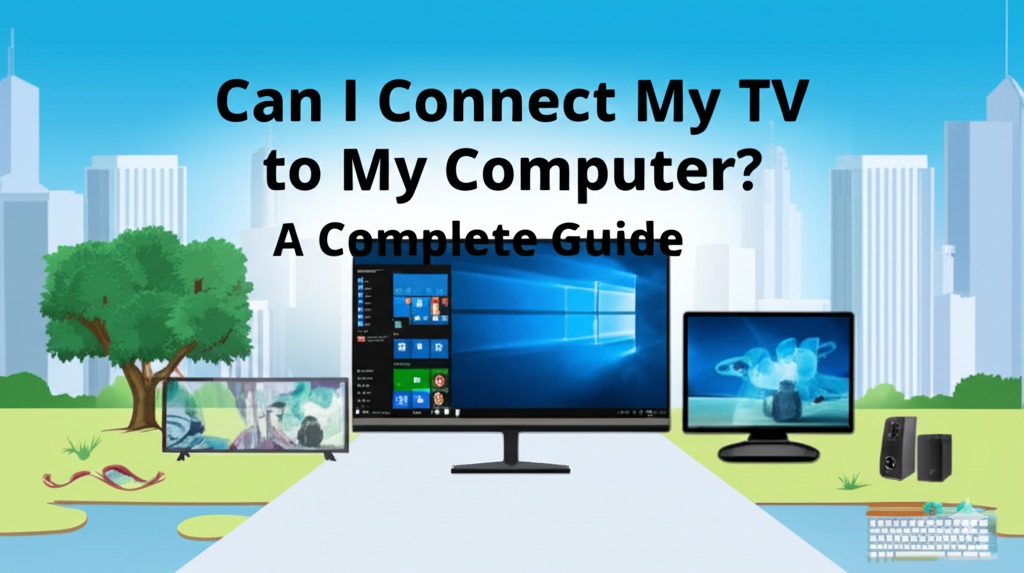In today’s digital world, many people are looking to enhance their viewing experience by connecting their TV to their computer. Whether it’s for watching movies, streaming shows, or even gaming, using your TV as a large display can offer an immersive experience. But how exactly can you connect your TV to your computer? In this article, we will break down the process, explore different connection options, and provide you with helpful tips to ensure a seamless setup.
Why Connect Your TV to Your Computer?
Before diving into the technicalities, let’s explore the benefits of connecting your TV to your computer:
- Larger Screen: Enjoy content on a bigger, more vibrant screen for an enhanced viewing experience.
- Streaming: Stream movies and TV shows from services like Netflix, Hulu, or YouTube directly to your TV.
- Gaming: Play computer games on a much larger screen for more immersive gameplay.
- Productivity: Use your TV as an extended monitor for work or productivity tasks, allowing you to multitask more effectively.
With these benefits in mind, let’s explore the different ways you can connect your TV to your computer.
Different Ways to Connect Your TV to Your Computer
There are several ways to connect your computer to your TV, each with its pros and cons. Let’s explore the most common methods.
1. HDMI Cable: The Most Common Method
The simplest and most reliable way to connect your TV to your computer is by using an HDMI cable. HDMI (High-Definition Multimedia Interface) allows you to transmit both video and audio signals from your computer to your TV.
Steps to Connect via HDMI:
- Plug one end of the HDMI cable into your computer’s HDMI port.
- Plug the other end into one of the HDMI ports on your TV.
- Switch your TV input to the corresponding HDMI channel.
- On your computer, adjust the display settings to extend or mirror the screen.
Using HDMI is straightforward, and it supports high-definition video and audio, making it ideal for watching movies, gaming, or working on a larger screen.
2. Wireless Connection: Miracast and Screen Mirroring
For those who prefer a wireless connection, Miracast and screen mirroring are popular options. Many modern laptops and TVs support Miracast, which allows you to wirelessly mirror your computer’s screen to your TV.
Steps for Wireless Connection (Miracast):
- Ensure your computer and TV support Miracast.
- On your computer, go to Settings > Devices > Bluetooth & Other Devices.
- Select your TV from the available devices list.
- Follow the on-screen prompts to connect.
Wireless connections are great for avoiding the clutter of cables, but they may suffer from latency or signal loss in some cases. For a more stable experience, a Wi-Fi Direct connection can be more reliable than Bluetooth-based solutions.
3. VGA or DVI Connection: Older Technology
If you have an older computer or TV, you may still have VGA or DVI ports. While these are less common today, they can still be used to connect your computer to your TV. However, keep in mind that these connections only transmit video, so you will need a separate audio cable for sound.
Steps for VGA or DVI Connection:
- Connect a VGA or DVI cable between your computer and TV.
- Use an audio cable to connect the computer’s headphone jack to your TV.
- Set the TV’s input to the appropriate port.
While these connections work, HDMI is usually the better choice for modern setups due to its ability to transmit both video and audio over a single cable.
4. USB-C to HDMI
If your computer only has a USB-C port, you can still connect it to your TV using a USB-C to HDMI adapter. This method works similarly to HDMI but requires an adapter.
Steps for USB-C to HDMI:
- Plug the USB-C to HDMI adapter into your computer’s USB-C port.
- Connect an HDMI cable from the adapter to your TV.
- Switch your TV input to the corresponding HDMI channel.
- Adjust display settings on your computer as needed.
This method is ideal for modern laptops and ultrabooks that use USB-C ports for multiple functions, including video output.
Tips for a Seamless TV-to-Computer Connection
To ensure that your connection is smooth and hassle-free, here are a few useful tips:
1. Check Display Resolution
Make sure your TV’s resolution is compatible with your computer’s output. If you’re streaming in 4K, ensure both your TV and computer support 4K resolutions for the best viewing experience.
2. Adjust Audio Settings
Sometimes, when you connect your TV via HDMI or other methods, you might need to adjust your audio settings to ensure that sound is transmitted to your TV. On Windows, you can do this by selecting the TV as the default audio device in your sound settings.
3. Use a Quality Cable
When using HDMI or other cables, make sure you’re using high-quality cables to avoid signal degradation, especially for high-definition video and audio.
4. Keep Your Software Updated
Ensure your operating system, display drivers, and TV firmware are up-to-date. Updates can improve compatibility and fix any issues related to connection.
Troubleshooting Common Issues
While connecting your TV to your computer is usually straightforward, you might encounter a few issues along the way. Here are some common problems and their solutions:
- No Signal: Double-check that all cables are securely connected. Try restarting both the computer and TV.
- No Sound: Ensure your computer’s sound settings are properly configured, and your TV is selected as the audio output device.
- Lag or Stuttering: If you experience lag, reduce the display resolution or use a wired connection instead of a wireless one.
Conclusion
Connecting your TV to your computer is a simple and effective way to enhance your entertainment and productivity. Whether you use HDMI for a reliable, high-quality connection or explore wireless options for a clutter-free setup, there’s a method to suit every need. Remember to check compatibility, adjust settings as needed, and follow the troubleshooting steps if you encounter issues.

Caleb Carlson is a contributing writer at Computer Site Engineering, specializing in computer technology, software trends, and hardware innovations. His articles simplify complex tech topics, making them accessible to readers of all levels.





